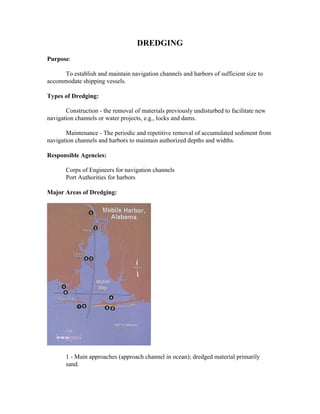Dredging facts
- 1. DREDGING Purpose: To establish and maintain navigation channels and harbors of sufficient size to accommodate shipping vessels. Types of Dredging: Construction - the removal of materials previously undisturbed to facilitate new navigation channels or water projects, e.g., locks and dams. Maintenance - The periodic and repetitive removal of accumulated sediment from navigation channels and harbors to maintain authorized depths and widths. Responsible Agencies: Corps of Engineers for navigation channels Port Authorities for harbors Major Areas of Dredging: 1 - Main approaches (approach channel in ocean); dredged material primarily sand.
- 2. 2- Bar channels (sandbars at inlets); dredged material primarily coarse-grained sand. 3 - Entrance channels (to harbors); dredged material primarily sand to fine-grained silt and clay. 4- Berthing areas (harbors/ports); dredged material primarily silt and some sand. 5 - Inland waterways (intracoastal waterways and river channels); silt and sand. Types of Dredging Vessels: Snagboat - Used to break up logjams and to clear debris, sunken vessels, and dilapidated piers that may be hazardous to navigation. Mechanical - Dipper dredge and clamshell dredge - removes hard packed material or debris - cannot handle fine-grained sediment, such as silt or sand - places materials into barges for transport to disposal sites
- 3. Hydraulic - - cutterhead pipeline dredge - uses rotating cutter at end of arm to suck loose materials into pipeline for deposit at a disposal site - can work 24 hours a day - limited capability in rough weather - pipeline can be obstruction to navigation - operates primarily in shallow draft navigation channels
- 4. • - self-propelled hopper dredge - stores sediment within vessel for disposal later at approved site - works in deep water (primarily in harbors and ports) - cannot dredge continuously - can operate in rough water • dustpan dredge and sidecaster dredge
- 5. - used to remove loosely compacted coarse-grained material at rapid shoaling sites or where sediment is needed adjacent to a navigation channel. Types of Disposal Sites Ocean Placement - off-shore site approved by Environmental Protection Agency for disposal - hopper dredge or towed barge with material from inlets, bars, and main approaches - vessel opens hull and allows sediment to drift to bottom of ocean Beach Nourishment
- 6. - placement of material on or near a beach - usually to replenish an eroding beach - typically done with pipeline and hopper dredges Upland Placement - placement of material directly into a diked area, usually by pipeline dredge - generally the most economical method of dredging
- 7. Open Water Placement - placement of dredged materials in near-coastal or inland waters - may include contaminated materials placed in deep pits or bottom depressions - material is capped in a precisely engineered manner to ensure cap stays in place and isolates material from environment. Within Banks Placement
- 8. - generally occurs on river system - material is placed on banks or downstream of shoals along shoreline - material, usually coarse-grained sand can be used commercially Environmental Benefits of Dredging - Can be used for the following purposes: - wetland construction - borrow pit relcamation - landfill cover - construction aggregate - beach nourishment - wildlife habitat • Scientifically approved measures to isolate contaminated materials from environment Extracted From Dredging, US Army Corps of Engineers Pamphlet, Undated.








